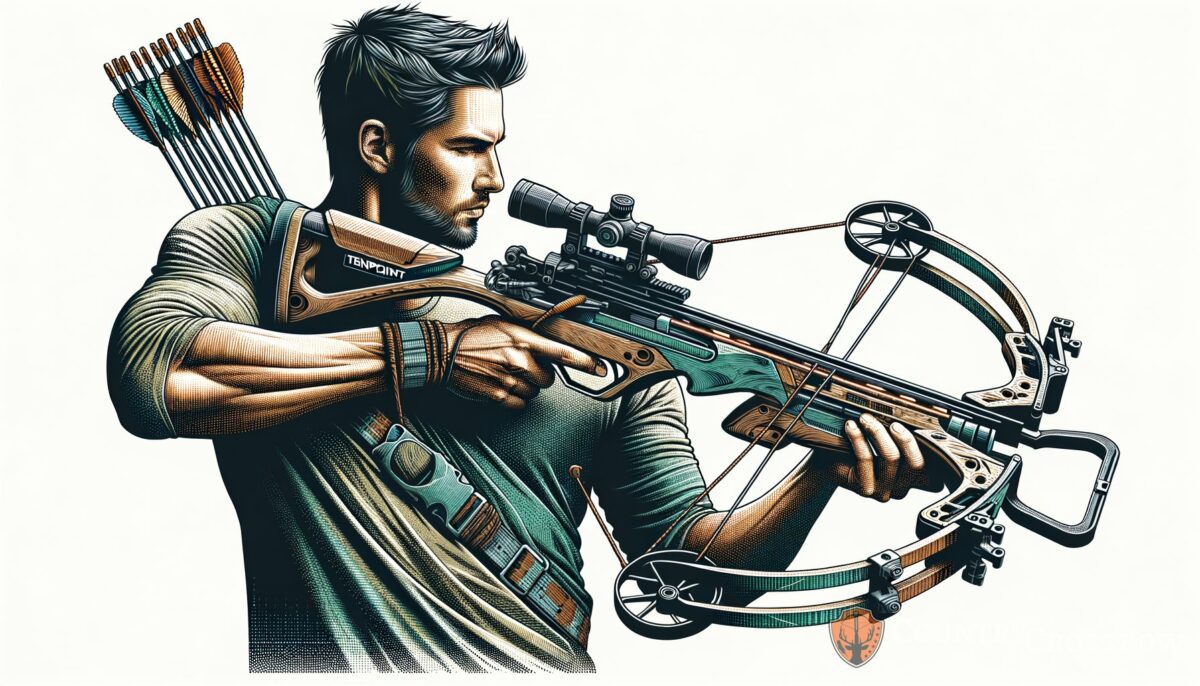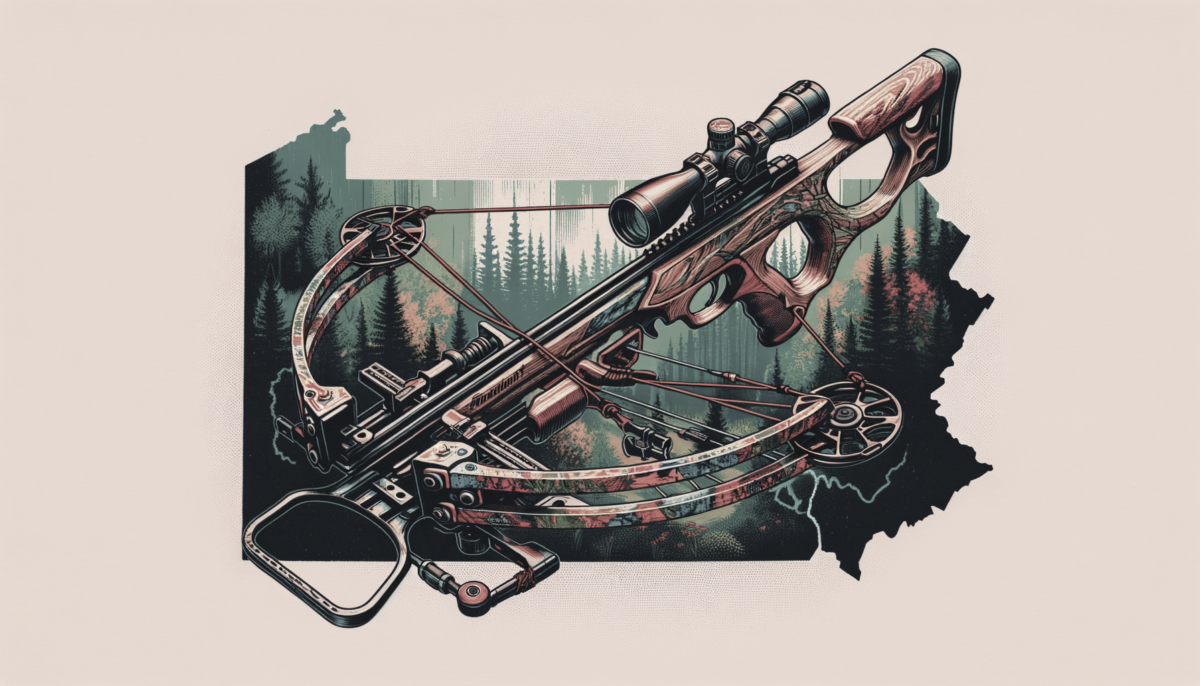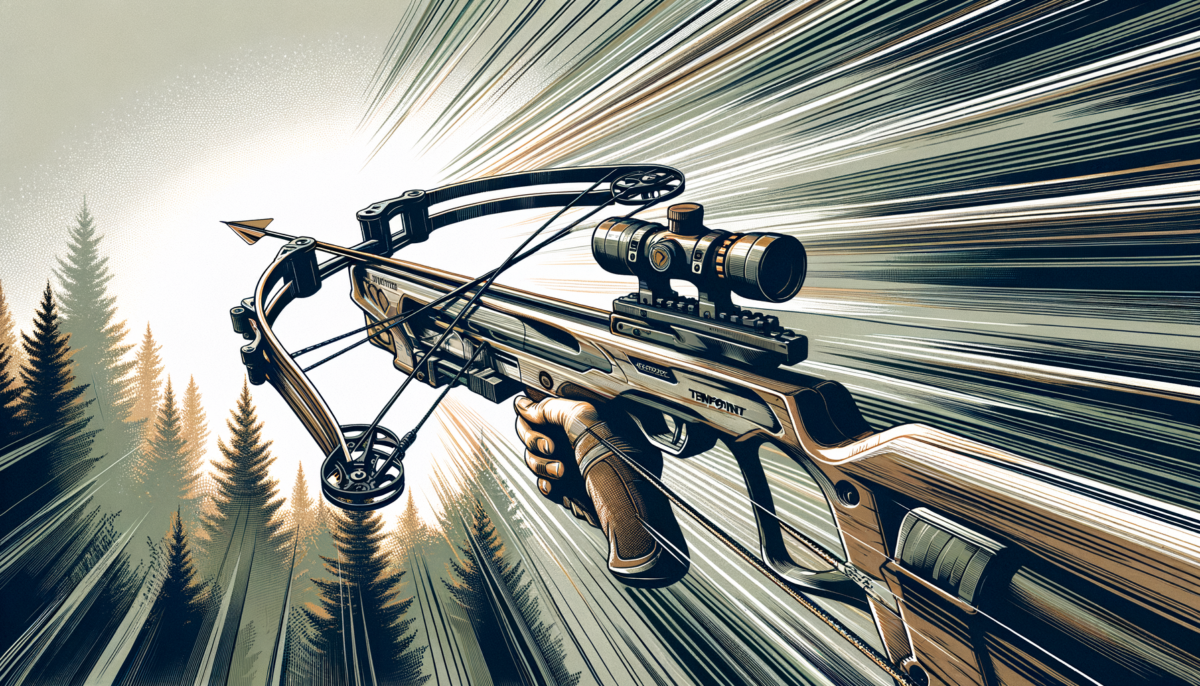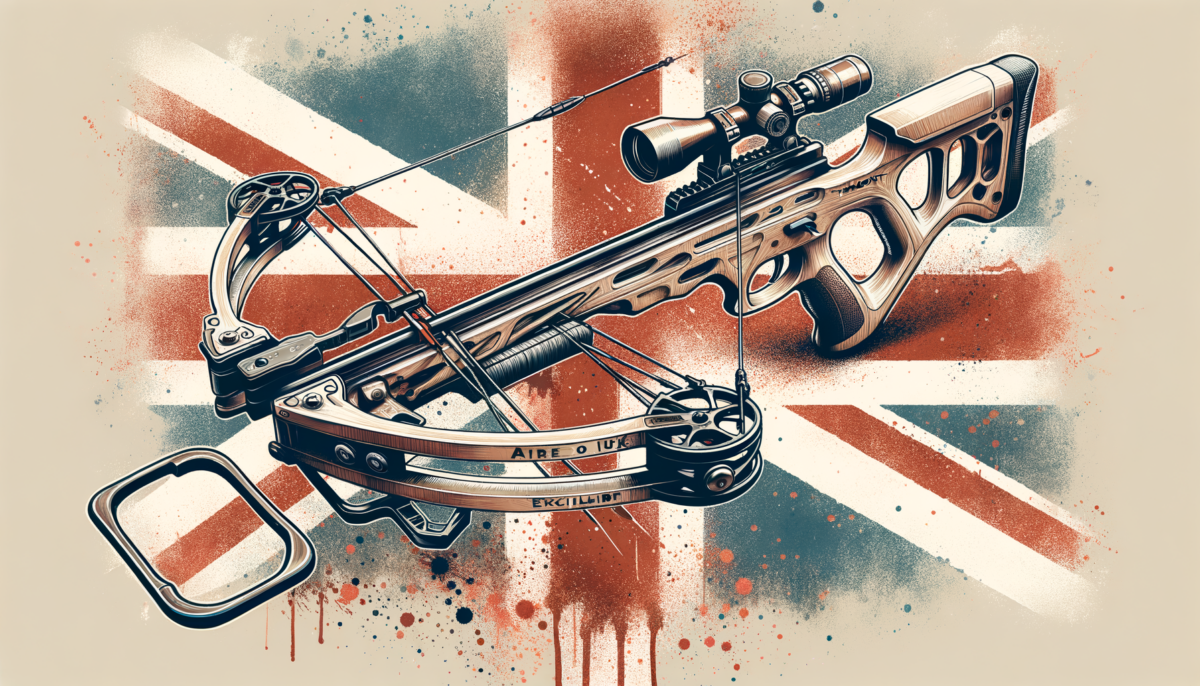Ever found yourself amazed at the vast array of crossbow optionsout there, from sleek carbon designs to classic wooden stock models? They’re not just medieval artifacts but modern precision tools personalized for archery enthusiasts. But have you ever wondered, amidst the jargon and specs,how do you choose the right crossbow draw weight? Indulge in an array of top-tier crossbows at your leisure, but remember, the draw weight is key to a spot-on choice. Here, we’ll cover the essentials to ensure your next bullseye isn’t left to chance.
Key takeaways
- Draw weight affects bolt velocity and overall energy efficiency.
- A balanced draw weight maximizes performance and minimizes strain.
- Proper maintenance and technique are crucial for crossbow longevity.
How to choose crossbow draw weight
Choosing the right crossbow draw weight isn’t just about raw power; it’s a blend of efficiency, purpose, and personal capacity. The draw weight is the force required to pull the string back to cock the crossbow. It’s a crucial factor because it directly influences the bolt’s velocity and, ultimately, the efficiency with which it strikes the target. Heavier draw weights are often associated with more power, but energy efficiency doesn’t scale up linearly, and with higher weights comes a higher possibility of energy loss through noise, friction, and heat.
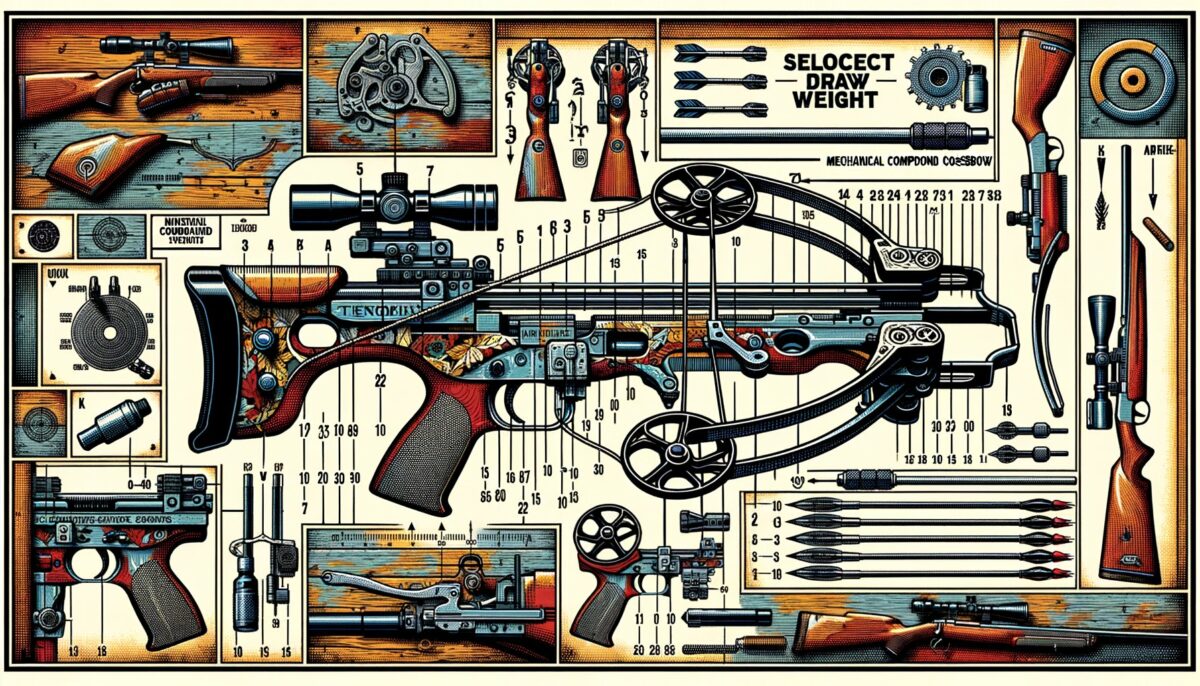
Now, while some might advocate the “more is better” philosophy, the reality is that energy efficiency and proper mechanics can make a modest draw weight surprisingly effective. It’s not just about the power to pierce; precision, arrow speed, and sustainability of shooting sessions also play into the equation. The idea is to find a sweet spot that offers reliable performance without overexerting the shooter or settling on the longevity of the bow and its string.
Here’s a quick rundown on why the right draw weight matters:
– Shifts focus from raw power to functional usability
– Balances energy output with efficiency to minimize loss
– Ensures consistent shooting performance and accuracy
– Matching draw weight to shooter’s physical capabilities avoids injury
Delve deeper into the nuances of choosing your crossbow, and discover best broadheads and best bolts to pair with your ideal draw weight.
Barnett Whitetail Hunter II

Barnett Whitetail Hunter II
Understanding draw weight
Draw weight is the backbone of a crossbow’s performance. It dictates not just the force required to cock the bow but also the potential energy moved to the bolt upon release. When selecting a crossbow, knowing the draw weight suitable for your intended use is crucial. But, what’s the deal with high draw weights and why don’t they always mean better performance? As draw weights increase, efficiency can actually decrease. Elevated draw weights can lead to more energy lost to factors unwelcome by a hunter or target shooter—noise, friction heat, and mechanical strain.
The fallacy that bigger is always better can lead to overlooking efficiency for brute force. Energy lost to the aforementioned factors can take away from the bolt’s speed and flatten your accuracy curve. The key is to balance enough force to achieve your purpose with a draw weight that doesn’t exhaust you or your gear. When you’re aiming for a target, whether in sport or hunting, applying massive force to cock your bow can lead to fatigue, which is harmful to precision. Anarchery bosscan be effectively penetrated with a draw weight as low as 40 pounds, giving evidence that manageable draw weights can still meet practical needs.
The physics behind draw weight

Energy efficiency isn’t as intuitive in crossbows as it is in some other mechanics. Understanding the reducing returns of increased draw weights is essential. The misconception is that doubling draw weight doubles the kinetic energy delivered to the bolt. The truth is, the relationship between draw weight and bolt velocity is not linear. This disparity is due to the complex interplay of energy transformation within the crossbow mechanism — increased draw weight doesn’t always equate to proportional increases in bolt velocity.
Choosing the right crossbow draw weight isn’t just about raw power; it’s a blend of efficiency, purpose, and personal capacity. The key is to find a sweet spot that offers reliable performance without overexerting the shooter or settling the longevity of the bow and its string.
Consider this: as you increase the draw weight from 40 to 175 pounds, the increase in velocity doesn’t match the increase in force required. Each pound of increase produces less and less additional velocity due to the aforementioned energy losses. Thus, eyeing a crossbow with a 175-pound draw weight may seem impressive, but if it’s only marginally faster than a 150-pound alternative, one has to question the additional strain on both shooter and equipment. Always consider a crossbow within your physical abilities tocock a crossbow —this ensures sustainable shooting and avoids injury.
Comfort and your crossbow
When you choose your crossbow, consider the comfort level associated with its use. A hefty draw weight may boast higher power, but can you manage it without pain or injury? Drawing a 175-pound crossbow requires important strength, and not everyone can handle that comfortably or safely, particularly over multiple ends. A lower draw weight like 40 or 105 pounds might be ‘on target’ for many users, allowing a pleasant shooting experience without leading to undue stress on your body or the equipment.
Repeatedly cocking a hefty crossbow can lead to muscle strain, fatigue, which can show as decreased accuracy over time. A crossbow that comfortably aligns with your body strength will allow for more consistent shooting. This ultimately means more enjoyable and successful sessions, whether you’re investing in acrossbow for competitive archery, casual backyard practice, or preparation for hunting season.
Crossbow draw weight and hunting
When it comes to hunting with a crossbow, draw weight becomes a discussion of ethics as well as efficiency. The goal is always a clean and humane kill, which requires a bolt capable of delivering enough kinetic energy to ensure deep penetration for a quick and ethical harvest. Hunters often seek heavier draw weights for larger game, with 150 to 175 pounds being commonly recommended. However, this power must be matched by accuracy and arrow placement, which are critical components for ethical outcomes.
High draw weight does not cancel the need for proper bolt selection and broadhead efficiency. In fact, the rightbroadheadcan improve the lethality of a bolt, even one propelled by a lower draw weight. This shows the broader narrative that while draw weight is a substantive consideration, it’s not the lone factor in successful crossbow hunting. Too much focus on draw weight may overshadow other vital elements, such as practice, shooting technique, and knowinghow far you can ethically shoot game with a crossbow.
Balancing power and efficiency
Energy efficiency tips the scales in favor of a sensible draw weight—a poundage that strikes a balance between deliverable kinetic energy to the bolt and manageable physical exertion. It’s tempting to covet what seems like a more powerful weapon, but savvy shooters know that the real game-changer is a crossbow that complements their strength and skill.
For most recreational target shooters, a draw weight between 40 and 80 pounds is more than sufficient. It gives enough force for meaningful practice without wearing down the shooter or the crossbow. For hunters, a higher draw weight might be necessary to ensure proper penetration on game animals, but remember that skill and precision place a paramount role. Seeking outcrossbow maintenance tips can help you ensure that your investment remains in top shape, offering optimal performance with every shot.
[SECTION = “Data table”]
Crossbow draw weight is a spectrum, and choosing where you fall on it is a matter that calls for deliberation. Let’s look at a data table that outlines key considerations based on the draw weights mentioned:
wp:table
| Draw Weight (lbs) | Expected Velocity Increase | Energy Efficiency | String Durability | Physical Strain |
|---|---|---|---|---|
| 40 | Low | High | High | Low |
| 80 | Moderate | Moderate | Moderate | Moderate |
| 120 | High | Low | Low | High |
| 150 | High | Lower | Lower | Higher |
| 175 | Highest | Lowest | Lowest | Highest |
/wp:table
Comparison of crossbow draw weights highlighting the trade-offs between velocity, efficiency, and user exertion.
Additional crossbow tips
Selecting the proper draw weight is just the beginning of your crossbow journey. To truly master the art, you’ll need to gather some practical advice and marry it with your ever-growing experience. Here are a few tips to get you closer to a true shot every time:
- Always start with shooting sessions using lower draw weight crossbows to build your technique without excessive fatigue.
- Gradually increase the draw weight as your strength and proficiency improve.
- Practice cocking your crossbow with the correct method to avoid injury and ensure even string alignment.
- Regular maintenance of your crossbow will lengthen its lifespan and keep accuracy; look up oncrossbow maintenance.
- Invest in quality bolts that are the right weight for your crossbow to improve performance.
Now for the dos and don’ts; these little nuggets of wisdom can make or break your crossbow experience. Following these guidelines helps ensure safety, effectiveness, and durability when engaging with your crossbow:
wp:table
| Do | Don’t |
|---|---|
| Do use a cocking device for higher draw weights to keep back health | Don’t neglect string and limb inspection before use |
| Do align crossbow bolts properly to prevent inaccurate shots | Don’t dry-fire your crossbow, as it can lead to severe damage |
| Do choose a proper crossbow scope for increased accuracy | Don’t store your crossbow cocked for lengthened periods |
| Do ensure your shooting stance is stable for consistent accuracy | Don’t ignore local regulations regarding draw weight and hunting laws |
/wp:table
Advantages and disadvantages of choosing a crossbow draw weight
Choosing the correct crossbow draw weight is a balancing act with real effects on your shooting experience. It’s necessary to weigh the benefits and drawbacks to make an informed decision that will improve your enjoyment and success in archery and hunting..
Advantages
- Improved Precision: The right draw weight allows you to shoot with greater accuracy and consistency.
- Reduced Fatigue: A manageable draw weight means you can practice longer without tiring.
- Lower Maintenance: Crossbows with lower draw weights generally require less maintenance.
- Greater Accessibility: Suitable for archers of all strengths and skill levels.
Disadvantages
- Limited Hunting Use: Lower draw weights may not be ethical or legal for hunting certain game.
- Reduced Range: Heavier draw weights typically offer longer shooting ranges.
- Potential Over-exertion: Higher draw weights can lead to strain if you’re not physically prepared.
- Noise and Vibration: At high draw weights, increased noise and wear on the crossbow can occur.
Selecting a crossbow draw weight is an exercise in personalization; what works for one might not suit another. It’s necessary to consider these advantages and disadvantages before locking eyes on your target purchase.
In my opinion, too much emphasis is placed on the notion that higher draw weights equate to a better hunting or target shooting experience. I’m continually struck by how effective a 40-pound draw weight can be, particularly when considering the balance between manageability and performance. Of course, higher draw weights may be necessary for certain types of game, but for many enthusiasts, lower draw weights are more than proper and significantly less daunting. After all, archery and hunting are as much about skill and patience as they are about the equipment. And it’s quite an eye-opener when you realize the specifications you thought were essential, might actually be overkill for your needs. For those seeking a deeper understanding, take a look at the detailed explanations ofwhat is the best weight for a crossbow bolt for hunting.
The archer’s skill, the quality of the scope, and even the choice of bolts play an immense role in the true capability of a crossbow. I firmly believe that a well-placed bolt from a 105-pound draw weight crossbow is, in many cases, as effective as one from a crossbow with a significantly higher draw weight. The idea is to match the equipment to the skill level and physical capability of the shooter, and to the specific requirements of the activity, be it target practice or hunting. Remember, it’s the archer, not the bow, that ultimately makes the shot.
wp:paragraph
If you are a visual learner, check out this video titled ‘How much power do you need in a crossbow?’
/wp:paragraph
wp:presto-player/youtube {“autoplay”:false,”id”:11,”src”:”https://www.youtube.com/watch?v=bxaSTB18vjM”,”preset”:1,”video_id”:”bxaSTB18vjM”} /
Frequently asked questions (FAQ)
What are the signs of a worn-out crossbow string?
Watch for fraying, stretched strands, or a noticeable decrease in the tensile integrity of the string. If you see these signs or if your string begins making unusual noises during cocking and release, it’s time to consider replacing it for safety and performance. Regular maintenance is essential, and usingthe best crossbow scopescan also help keep string life by improving shot accuracy and reducing the need for excessive firing.
How often should I replace my crossbow string due to wear and tear?
Although it varies by usage and draw weight, replace your crossbow string every two years or after about 200 hours of shooting. However, always inspect your string before and after each use, and replace it sooner if you watch any signs of wear or damage. Proper care can lengthen the life of your string, so be sure to follow manufacturer guidelines and learn aboutcrossbow maintenance.
Can I use any scope on my crossbow, regardless of the draw weight?
Yes, you can, but it’s not just about attaching any scope; it’s about finding the right scope that complements your crossbow’s draw weight and intended use. Higher draw weight crossbows may benefit from a scope with advanced features such as a rangefinder to capitalize on their lengthened range. For lower draw weights, a clear and simple reticle might suffice. Choosingthe best crossbow scopeimproves accuracy and shooting experience across the board.
Final thoughts
As we’ve drawn back the string and released the bolt on this topic, what stands clear is that choosing the right crossbow draw weight is as much about personal mechanics and use case as it is about the crossbow itself. The engines of precision and efficiency aren’t solely powered by the draw weight, but a harmony of many factors, including energy efficiency, superb broadheads, and proper bolts. It’s about striking a balance personalized to your body, your skills, and your needs.
How do you feel about draw weight now? Did I cover everything you wanted to know? Let me know in the comments section below; I read and reply to every comment. If you found this article helpful, share it with a friend, and check out my full blog for more tips and tricks on choosing crossbow draw weight. Thanks for reading and may your next outing be right on the mark!



